This Greek ceremonial bread, called Artos, is usually brought to church as an offering. It’s slightly sweet and very aromatic, great for breakfast or snack.
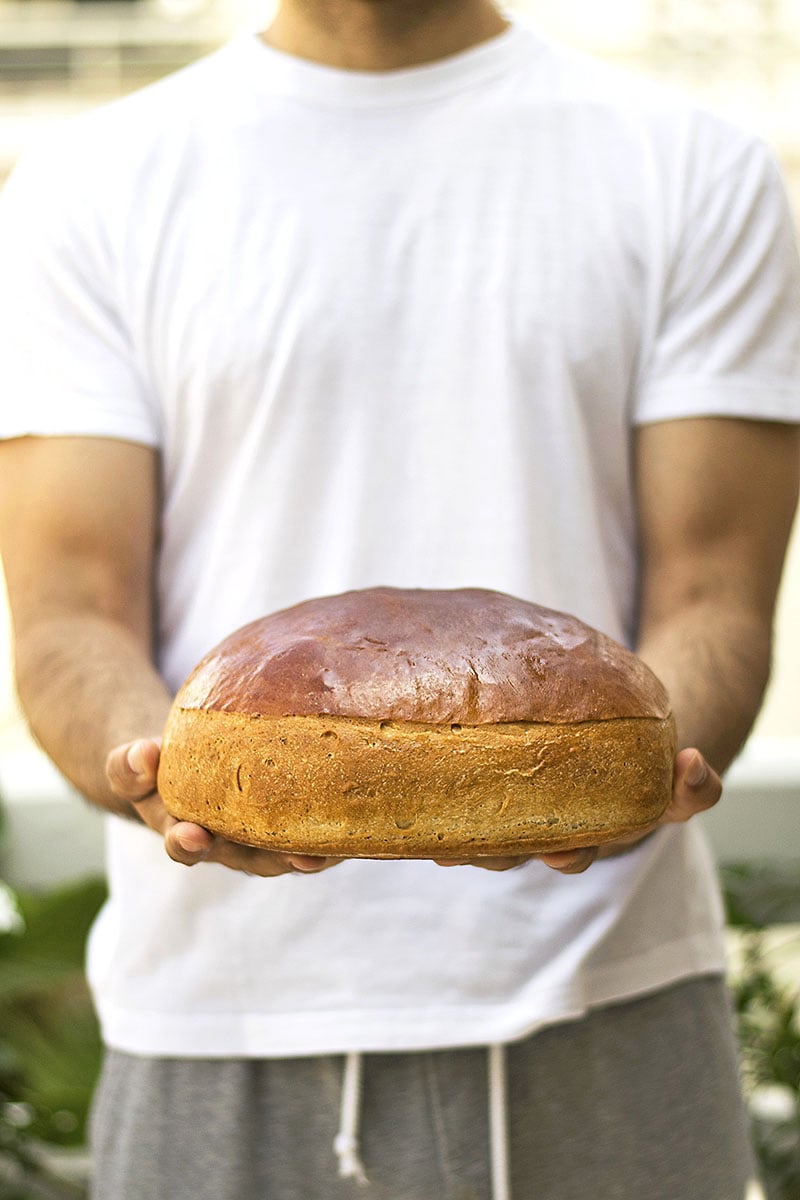
This Greek ceremonial bread (Artos) or Greek blessing bread is scented beautifully with some spices and has just a little sweetness to make things more interesting. And needless to say, it’s one of my favorite breads (I could eat it all day!).
You can eat it for breakfast with a glass of milk or some Greek mountain tea, or as a snack with your afternoon Greek coffee and a generous slice of cheese.
And those of you with a sweet tooth, note that it’s perfect when slathered with praline or chocolate spread, though some peanut butter and jelly (or tahini and honey) will also do!
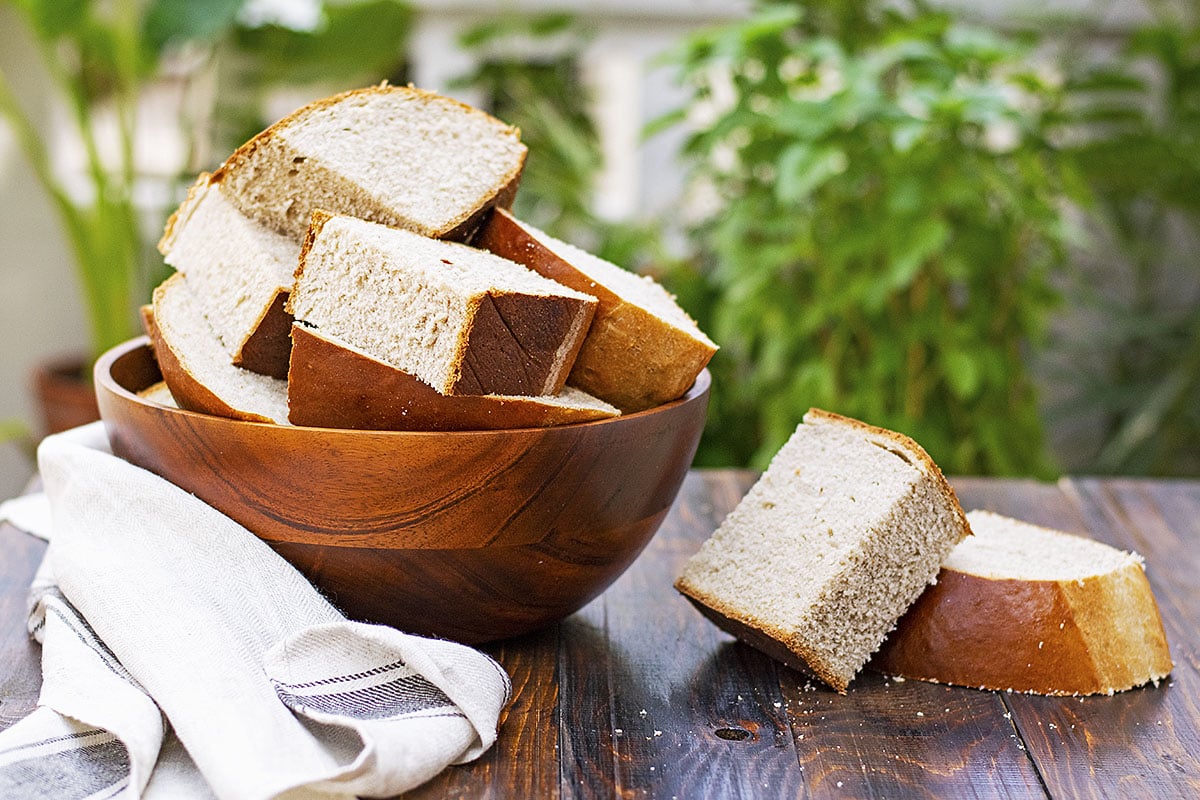
“Artos” means “bread” in ancient Greek, but nowadays the term has been replaced by the word “psomi”. So, when someone says "Artos" he’s almost always referring to the special type of ceremonial bread which is brought to church in order to get divided and shared with all the people. It’s something like an offering.
These offerings happen during certain holidays and occasions, and the people who want to participate always bring 5 Artos to the church. At the end of the ceremony and after all the Artoi (plural) have been blessed, the four of them will be cut into pieces and shared with the congregation while the fifth will be taken home by the one who brought it.

There are many breads closely connected with Greek Orthodox tradition like this Greek Easter bread (tsoureki). There’s even a very moist and fluffy vegan oil cake, this Fanouropita which is made in the name of St. Fanourios! But Artos, maybe because of its size or maybe because of the whole ritual that surrounds it, is my favorite. And let’s not forget how good it tastes!
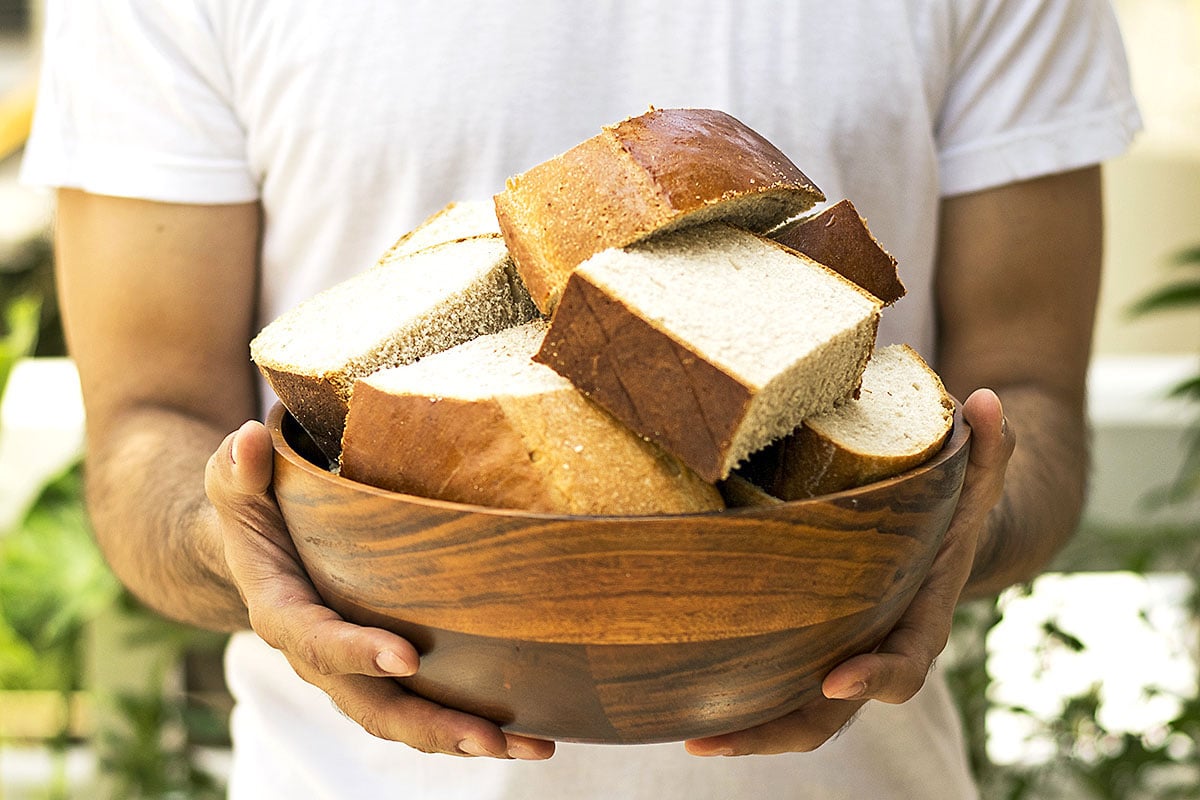
The marks and the scoring
Because of its’ religious character, Artos carries certain Orthodox symbols on its surface, transferred by a special wooden stamp. (However, no matter how hard I press the stamp, I almost always fail to make the marks to stay after baking).
Also, before baking, it is scored horizontally, another symbolic action which represents the separation of the earth from the sky. This scoring also helps the bread to expand vertically and keep its surface smooth without any cracks.
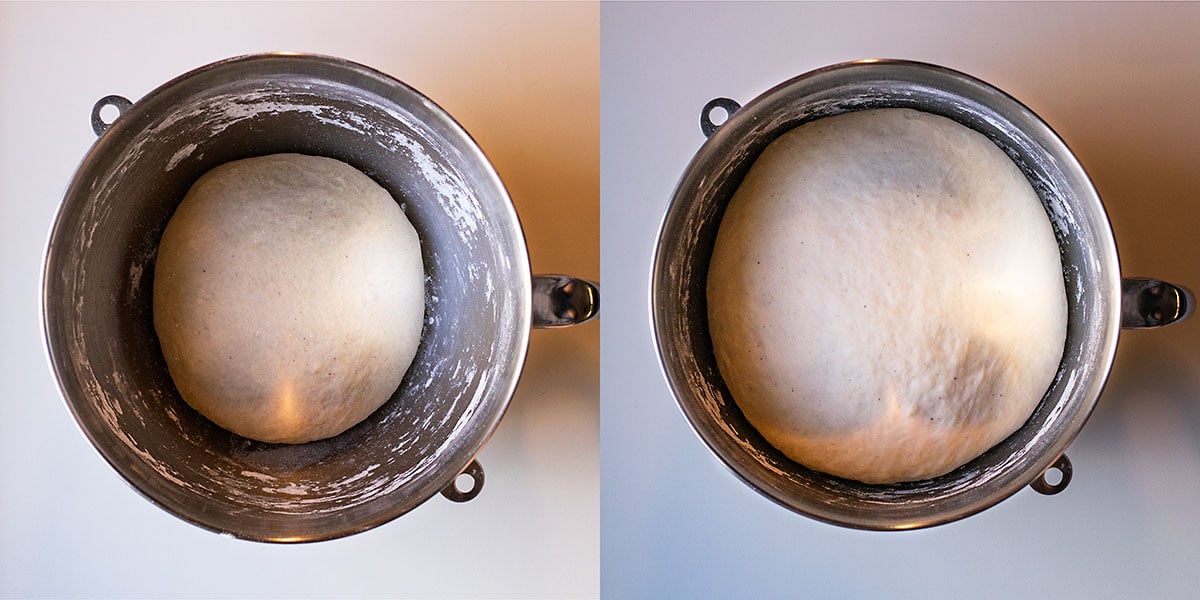
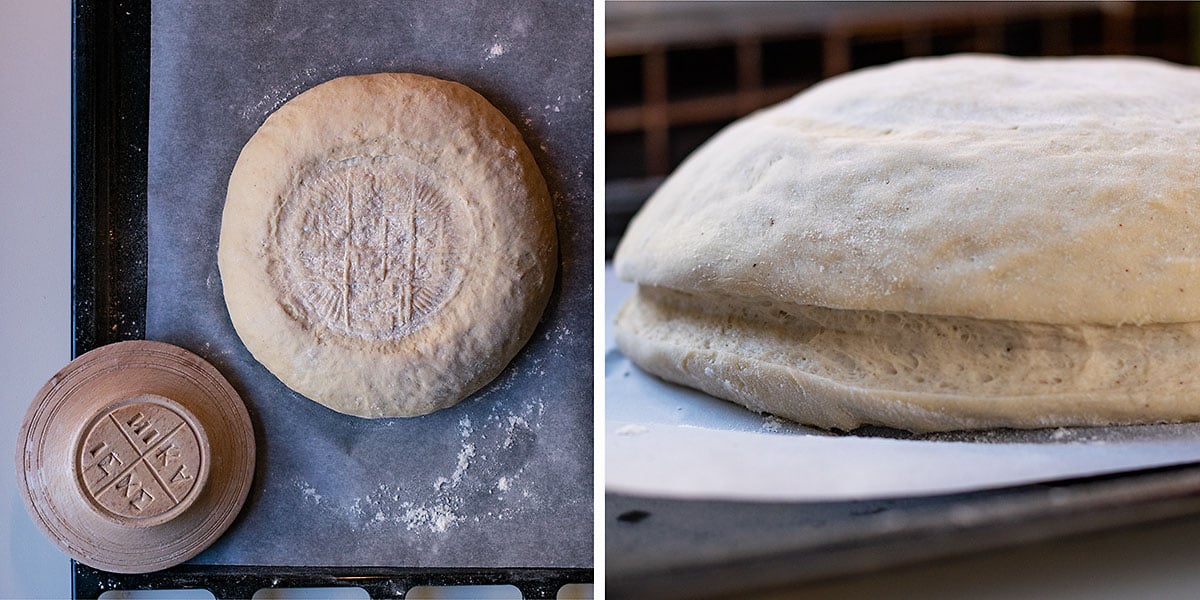
Some notes/tips:
- Make sure the scented water is not hot, because it will kill the yeast. Dip your finger and it should feel just warm.
- In some places, especially outside Crete, aniseed may be used but I am not particularly fond of it, so I never use it.
- The time required by the bread to rise will depend on the temperature of your kitchen and the strength of the yeast. Usually, 2-4 hours are needed for the first rise of the dough.
- Brush the ceremonial Greek bread with a simple syrup just after you take it out of the oven. This will give it a glossy look. It will be sticky at first, but when dry it will be ok.
- Keep the bread well-wrapped with cling film and inside a ziplock bag to keep it fresh.
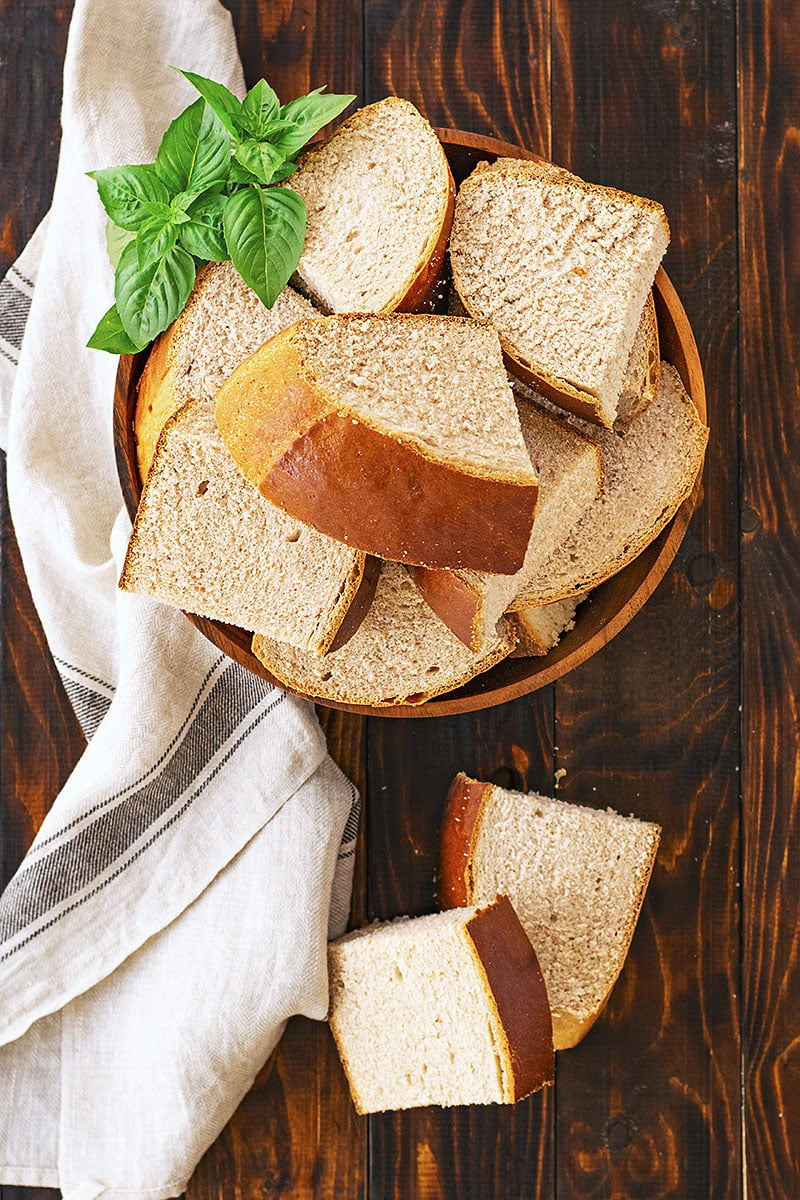
You may also like these similar recipes:
Greek Village Bread Recipe (Horiatiko Psomi)
Chickpea starter Cretan traditional bread (Eftazymo)
Carob and whole wheat flour bread with walnuts
Share this post if you liked it (share buttons at the top!) and don’t forget to subscribe for new recipes or follow me on Instagram, Pinterest, Facebook
📖 Recipe

Greek ceremonial bread recipe (Artos)
Ingredients
- For the scented water:
- 1 ½ cups water
- 2 bay leaves
- 2 cinnamon sticks
- 6 cloves
-
- For the bread:
- 1 cup (250 grams) scented water
- 2 cups (250 grams) bread flour
- 2 cups (250 grams) all-purpose flour
- 1 tablespoon or 1 envelope (9 grams) active dry yeast
- ½ cup (100 grams) sugar
- 2 tablespoons (30 grams) maple syrup (or honey for non-vegans)
- 2 tablespoons (30 grams) brandy or red wine
- 2 tablespoons (27 grams) olive oil
- ½ teaspoon ground cinnamon
- ½ teaspoon salt
- extra flour for kneading
-
- 2 tablespoons boiling water
- 1 teaspoon sugar
Instructions
- Make the scented water: Transfer the water, the bay leaves, the cinnamon, and the cloves to a small pot and bring to a boil. Turn off the heat and let it come to room temperature. Pass the water through a sieve.
- Make the Artos bread: In the bowl of your electric mixer mix 1 cup of the scented water, 1 tablespoon for the flour, the yeast and a pinch of sugar. Let it rest in a warm place for 5-10 minutes or until foamy. Then, add the rest of the flour, the sugar, the maple syrup or honey, the wine, the olive oil, the cinnamon and the salt. Knead with the dough attachment until a soft and pliable dough forms (about 10 minutes). If the dough is sticky, add the extra flour.
- Cover the bowl with a clean towel and let it rest in warm place until tripled in volume (about 2-3 hours).
- Punch the dough to deflate it, knead, and shape it into a ball. If you have the Artos stamp, dust it with flour and press it firmly on the center of the ball. Otherwise, flatten the ball with your hands to form a disk. Let it rest in a warm place until almost doubled in volume. In the meantime, preheat your oven to 350°F (175°C).
- Score the sides of the bread horizontally and bake for 50 minutes. If you notice that the surface browns quickly, cover with foil.
- Take the bread out of the oven and let it rest on a rack. Mix the boiling water with the sugar and lightly brush the surface to make it glossy. Let it cool completely.
- Eat!
Notes
To make one Artos the traditional size, you’ll need one and a half of this recipe.
Nutrition
If you like this recipe, Pin it!
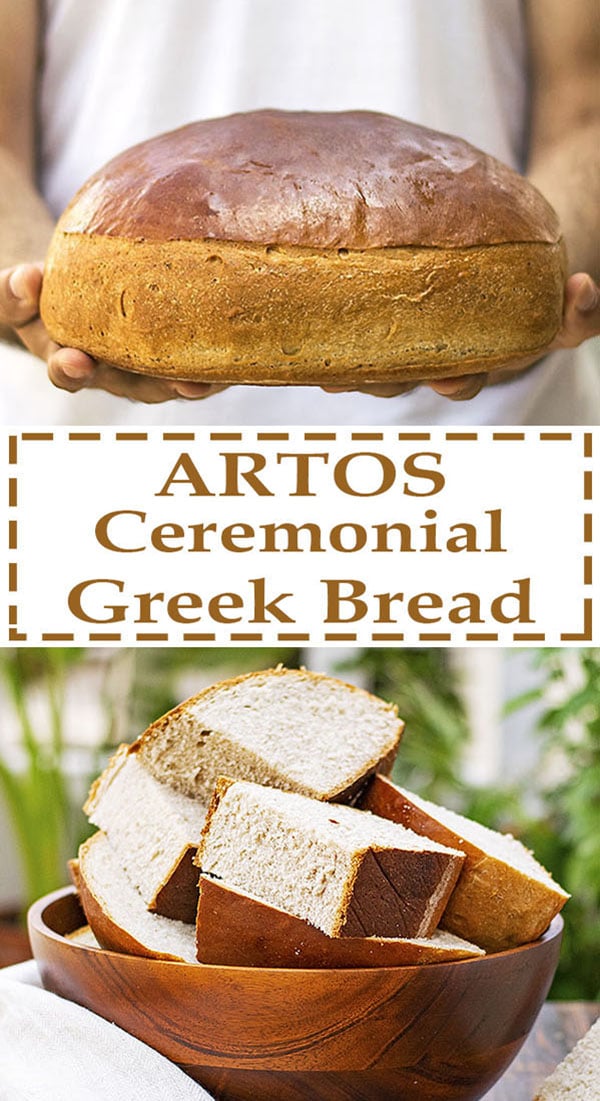

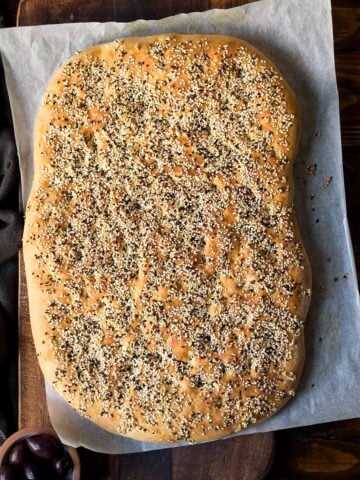
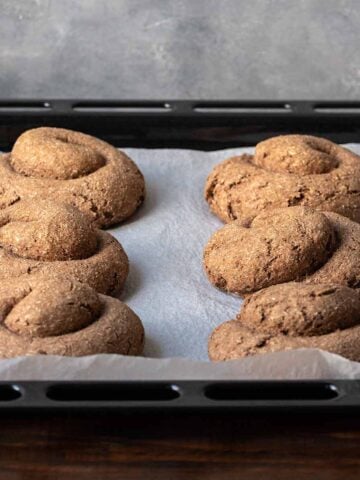
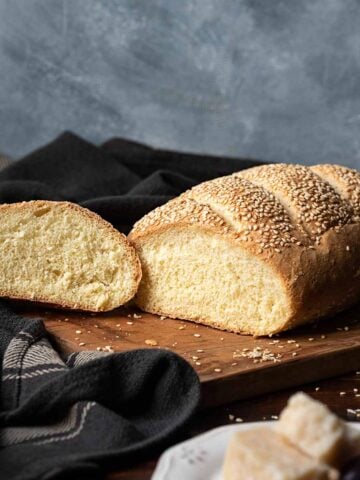

ofeliawood says
it is a great food for snacks and breakfast that I truly enjoy
Makos says
Thank you Ofelia!
Akhila@Pepper Delight says
That crust...Yum, I wish I had a big slice of this bread with my coffee right now, it looks great!
Makos says
Thank you Akhila! It's also great with some cheddar and a cup of tea!
Amalia says
ok, so I was having a look through your site and everything looks good and the recipes seem reliable. BUT when I came across this I knew I had to pay more attention – this is a favourite of mine too and it is never for sale at the bakeries because they make it on order. I have never seen a recipe online for it either so thank you. I will try it … with some aniseed ?
Makos says
Thank you very much Amalia!
I hope you like it (with or without aniseed :P)
Elena says
Kalimera Mako
se eyxaristw poly gi ayti ti syntagi pou eftiaksa xtes gia prwti fora. O artos egine poly nostimos, myrwdatos kai mou thymise ta paidika mou xronia stin Kriti. Tha tin ftiaxnw taxtika mia kai mou aresei gia prwino me ricotta (spania briskw myzithra stin Agglia) kai meli. Episis tha dokimasw ki alles syntages sou, oles fainontai pentanostimes. An kapoia stigmi mporeseis, mia syntagi gia koulourakia anebata tha itan poly kalodexoumeni.
Xairetismata apo Londino.
Makos says
Σας ευχαριστώ πολύ!
Κι εμένα είναι ένα από τα αγαπημένα μου ψωμιά αυτός ο άρτος, και μου φέρνει πάντα πάρα πολλές αναμνήσεις 🙂
Όταν λέτε ανεβατά, εννοείτε με μαγιά σωστά; Στο χωριό μου ανεβατά λέμε τα καλιτσούνια με γέμιση από μυζήθρα
Elena says
Eyxaristw gia tin apantisi.
Ta anebata kalitsounia exoun ti xari tous (an kai protimw ta lyxnarakia!), alla sto diko mou xwrio (nomos Irakleiou) eftiaxnan malaka koulourakia xwris gemisi, gia ton kafe. Eixan sigoura magia sti zimi kai itan paspalismena me sousami. Ta kserw ws anebata. Dystyxws kaneis stin oikogeneia den kratise tin syntagi.
Makos says
Θα το ψάξω και θα σας πω 🙂
Vicky Argyropoulos says
Hi!!!
I’m wondering, can I omit the olive oil so it’s completely lenten?
Makos says
Hi, yes the quantity is not too much, so you can omit it 🙂
Efi says
One of my favorite recipes, thanks!
Sophia A Niarchos says
I need to make a five-loaf artoklasia for the feast of Epiphany. I am trying to understand several things in your recipe:
In the beginning, you say the recipe makes one loaf. At the end you say:
“This recipe makes 10 large servings.” Do you mean 10 loaves or 10 slices? If it’s a ceremonial offering, don’t we need a recipe for 5 loaves?
Then you say:
“To make one Artos the traditional size (what other size would we want for an artoklasia?),you’ll need one and a half of this recipe.” Don’t we need the recipe multiplied by 5 for the artoklasia?
Why is only one cup of the 1.5 cups of scented water used for one loaf? Do we multiply that and all ingredients by 5 for 5 loaves?
Thank you.
Makos says
Hi Sofia, this recipe makes one loaf that you can cut in 10 large slices (servings) and it's meant to be an easy bread recipe for an everyday baker to try.
The traditional Artos is a very large loaf, and it may be difficult for an amateur baker to handle and bake. That's why nowadays almost everyone orders the artoklasia (the 5 artos bread) from a bakery.
If you want to make a whole artoklasia by yourself (the traditional size), you will have to make 1.5 recipe for each loaf.
However, sometimes people make smaller loaves (especially if they're homemade) so you can follow the recipe as is and make it 5 times for 5 smaller artos bread.
This can be a LOT of work, so you'll need good planning.
Hope that helps, please let me know if there's anything else you need.
Good luck!
Sophia A Niarchos says
Thank you for explaining andnoffering options.
I forgot to tell you that someone offered the artos made with your recipe at church on his saint's feast day, and I loved it.
The only other question left is about the amount of scented water.
Makos says
Ah yes, sorry I forgot about that
I use 1 1/2 cups water to make the scented water because some of it will evaporate during boiling. From that water you will use 1 cup to add to the recipe.
Sophia A Niarchos says
Thank you for explaining about the evaporation. Makes sense. I didn't have the time or patience to add fractional mathematics to the process of making the five loaves. I made a recipe I've made before, found on the church web site of Prophet Elias Greek Orthodox Church in Santa Cruz, California. Perhaps in the future, I will plan better to be able to use your unique and tasty recipe.
Karly says
What size pan do you bake your loaf of bread in? A 8, 9 or 10 inch pan?
Makos says
Hi Karly, I bake it in a flat black pan covered with parchment paper (you can see it in one of the pictures). If you want you can bake it in a 10 inch round pan but the bread doesn't have to cover the entire surface.
Sandy says
Hi what if I have a 7×3 baking pan?
Makos says
Hi Sandy, I 'm afraid I don't understand the question. You mean to bake it in a loaf pan?